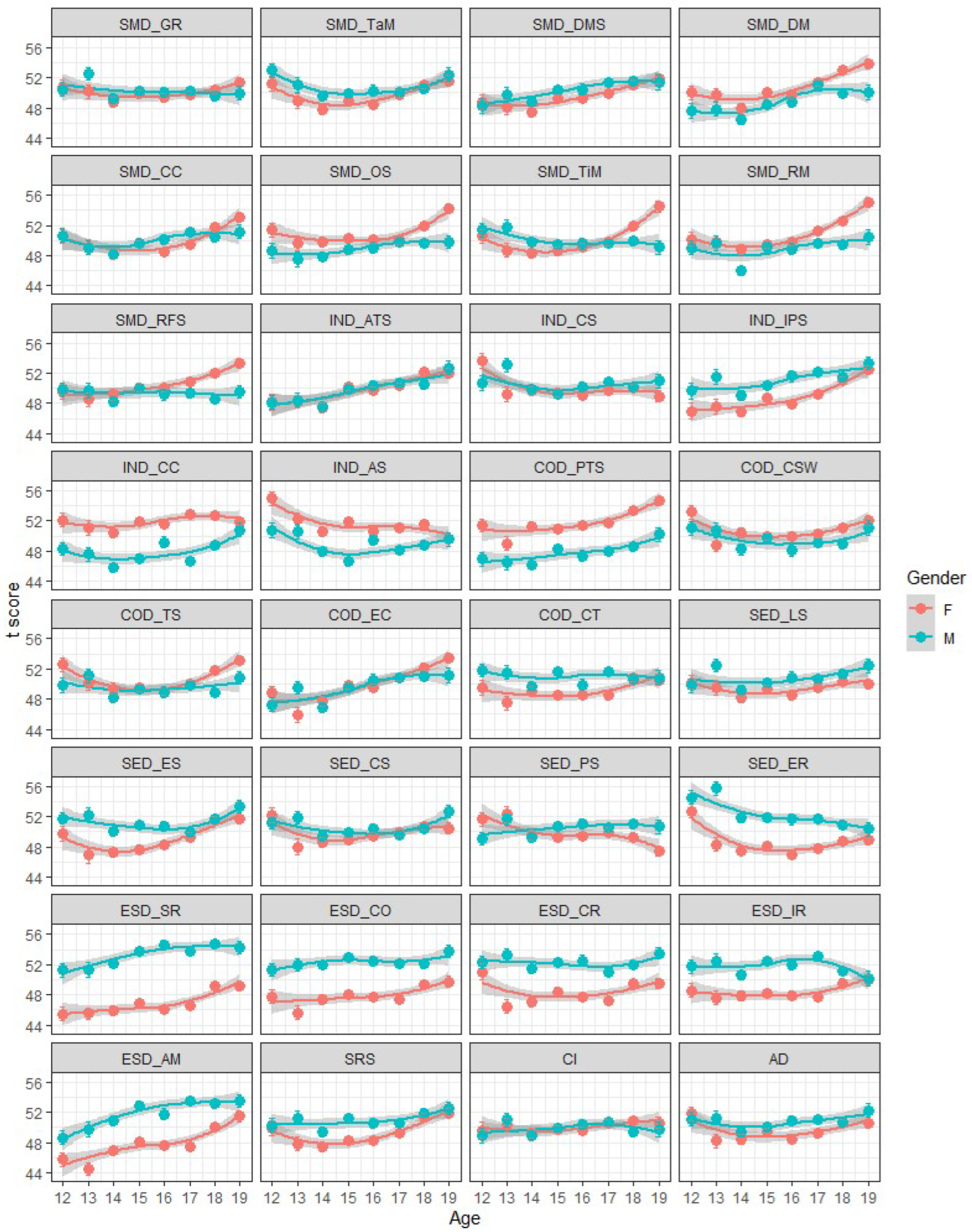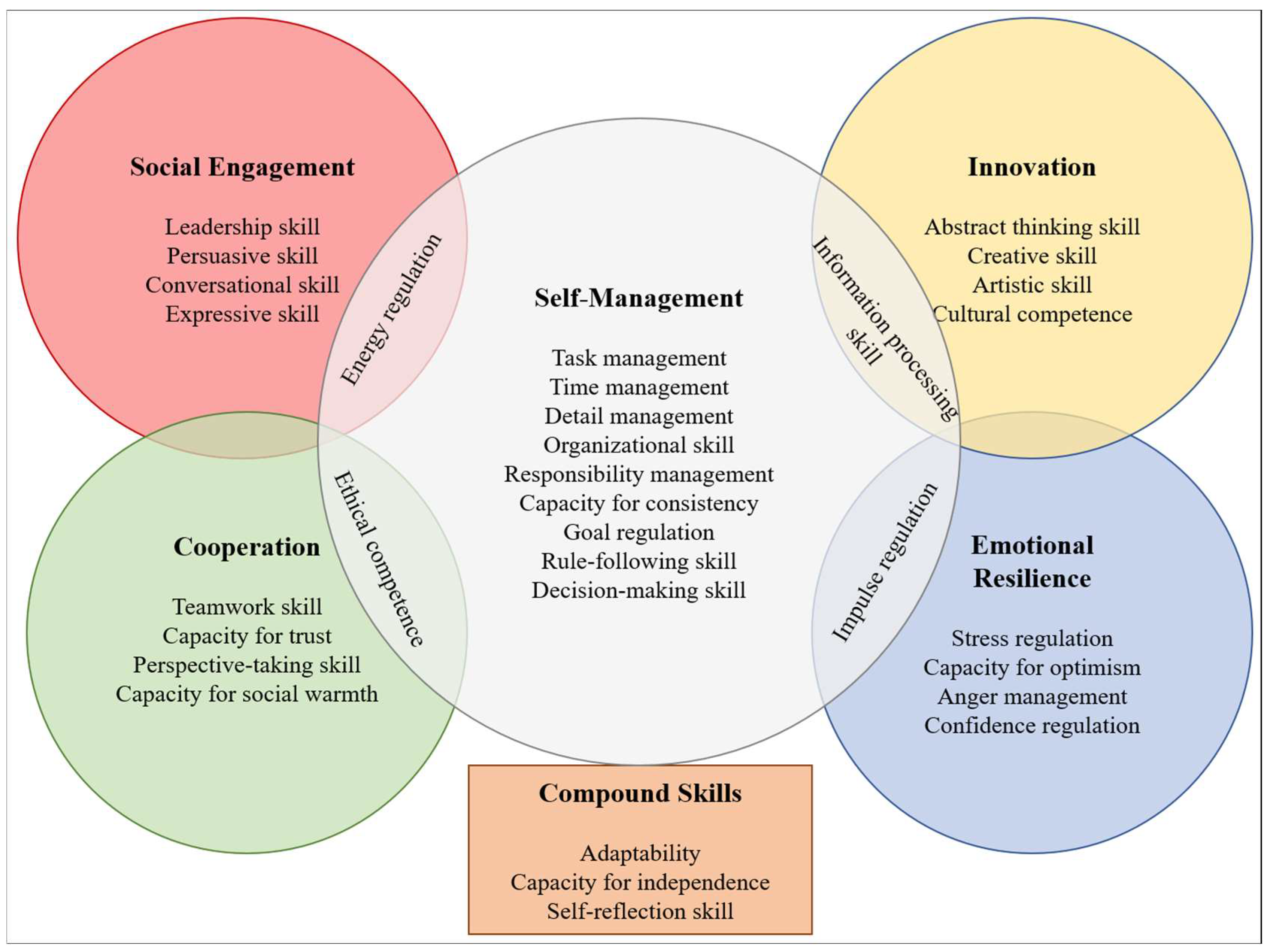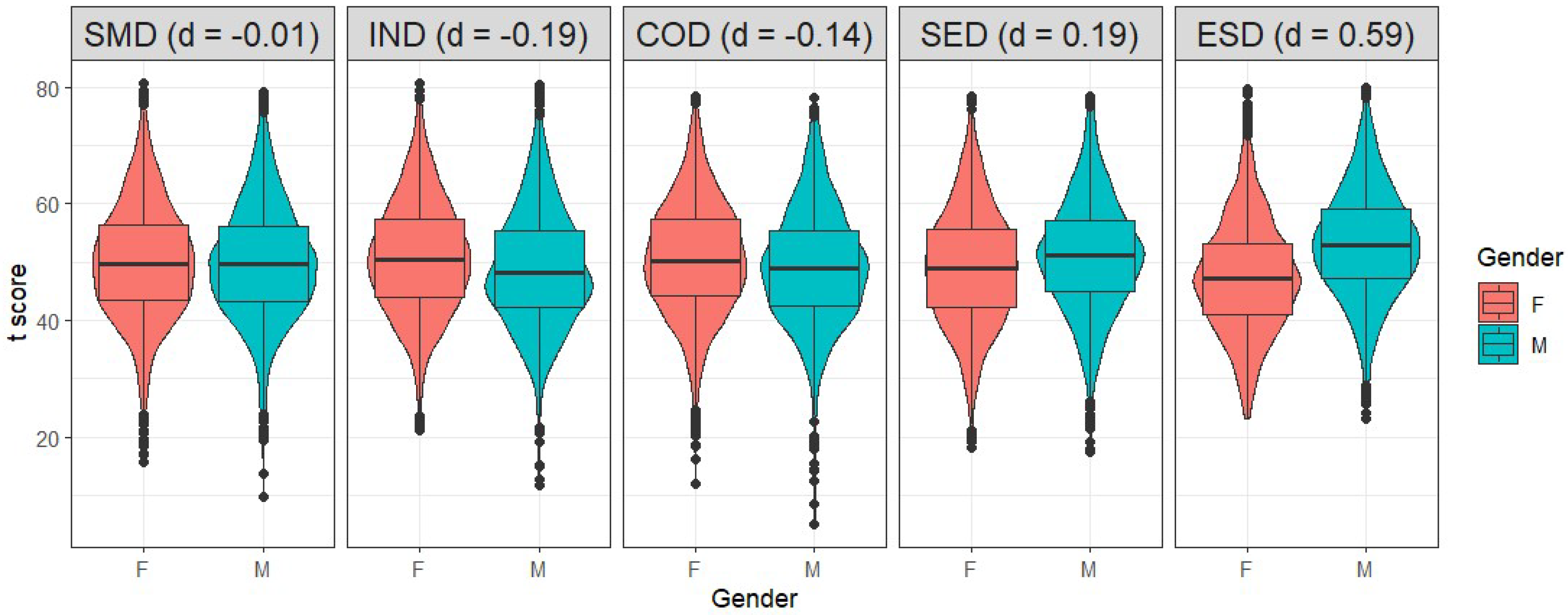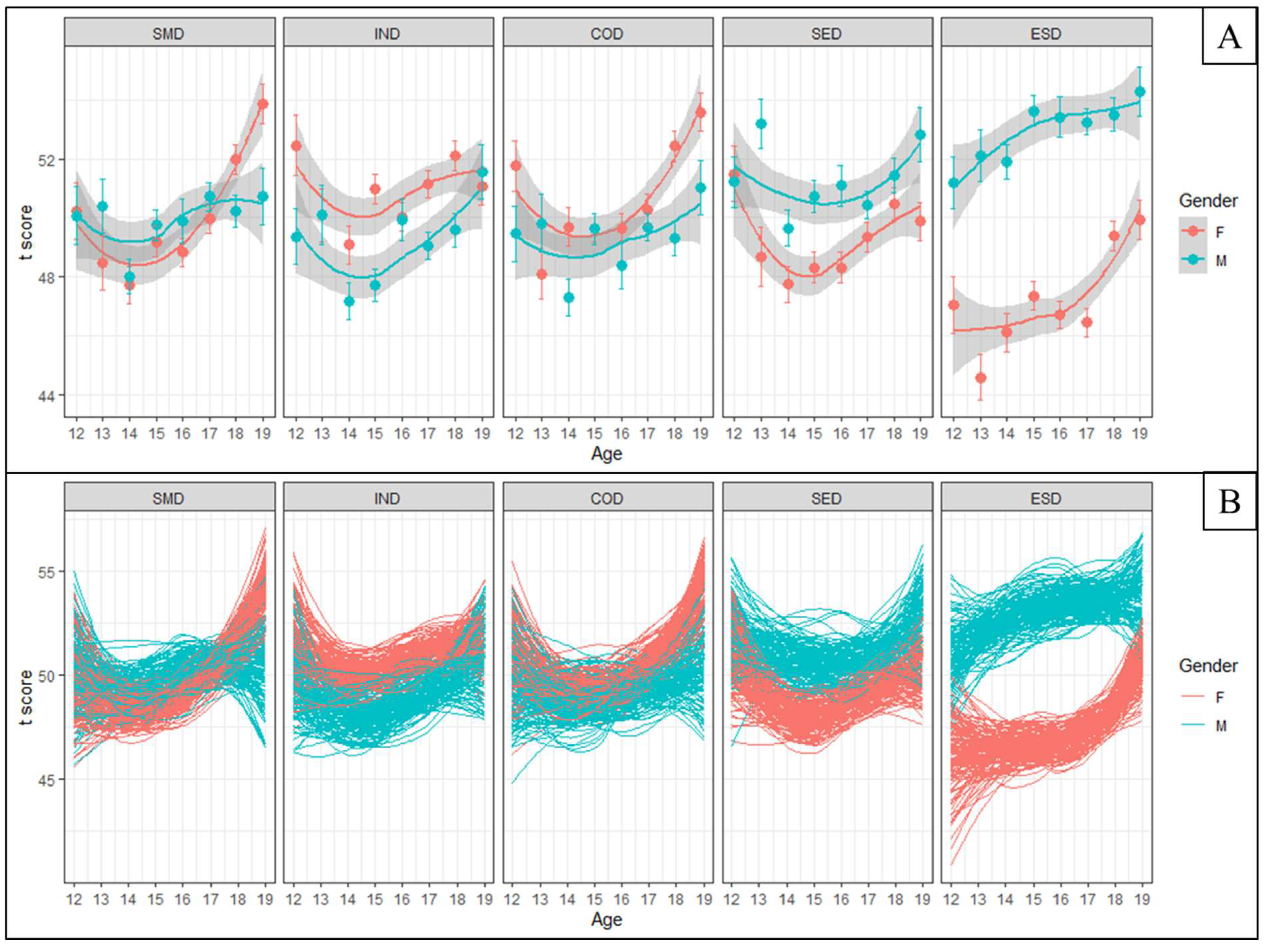Social, Emotional, and Behavioral Skills: Age and Gender Differences at 12 to 19 Years Old
Abstract
1. Introduction
1.1. Social, Emotional, and Behavioral Skills
1.1.1. The Framework and Measurement of SEB Skill
- Self-management skills (e.g., task management, time management, goal regulation) encompass the skills people use to effectively set, plan, and reach their goals or complete tasks.
- Innovation skills (e.g., abstract thinking and creative skills) are people’s capacities to handle, learn, create, and engage with new ideas and experiences.
- Cooperation skills (e.g., teamwork and perspective-taking) are the abilities people use to build and maintain positive social relationships.
- Social engagement skills (e.g., leadership and conversation) are the abilities that people use to communicate and actively engage with others.
- Emotional resilience skills (e.g., stress regulation and impulse regulation skills) are skills that people use to regulate their emotions and moods efficiently, depending on the requests and situations at hand.
1.1.2. SEB Skills between 12 and 19 Years Old
1.1.3. SEB Skills and Gender
1.2. Rationale of the Study
1.3. Hypotheses
- Although this is the first study exploring age and gender differences in SEB skills, and we do not have specific hints from the literature about how they should vary during adolescence, we preregistered our hypotheses (https://osf.io/f5png) based on two large studies on personality traits (Soto 2016; Soto et al. 2011). On this basis, we expected that:
- Self-management skills should follow a U-shaped trajectory between 12 and 19 years old. This trajectory should be similar for males and females.
- Innovation skills are expected to be stable across ages and similar between males and females.
- Cooperation skills should be stable with age and higher in females than males.
- Social engagement skills should decrease with age and be higher in females than males.
- Emotional resilience skills should be higher in males than females, and such differences could increase through adolescence.
2. Materials and Methods
2.1. Participants
2.2. Measures
2.3. Procedure
2.4. Data Analysis
2.4.1. Transformation and Inference Criteria
- Small if they amounted to ~2 T-points.
- Medium if they amounted to ~5 T-points.
- Large if they were higher than 8 T-points.
2.4.2. Preliminary Analyses
2.4.3. Model Comparison
- A null model (intercept only, m0) was used as a baseline for all comparisons.
- A model with only age as a linear predictor (m1) that only assumed an effect of age on the dependent variable.
- A model with interactions between age and gender (m2) assumed that the effect of age is linear but different between males and females.
- A model (m3) in which the same assumptions of m2 were made, but the effect of age was expected to follow a quadratic trend (i.e., the age trends follow a curvilinear pattern).
- A last model (m4) in which the effect of age was expected to follow a cubic curve (i.e., the curve goes up and down multiple times).
2.4.4. Graphical Analysis
2.4.5. Additional Analysis
3. Results
3.1. Preliminary Analysis
3.2. Model Comparison and Graphical Analysis
- For self-management skills, the quadratic model with interaction was the best (m3). All effects within the model were also significant, highlighting a different curvilinear relationship between age and self-management skills in males and females.
- For innovation skills, the cubic model was selected (m4), but no significant interaction effects emerged from the results of the model. In other words, similar trajectories emerged in males and females.
- For cooperation skills, the quadratic model was selected (m3), but the interaction effect did not reach significance (p = .09), highlighting similar trajectories between males and females.
- For social engagement skills, the cubic model (m4) was selected. All effects within the model were also significant, highlighting a difference in the mean level and the trajectories between males and females.
- For emotional resilience skills, the quadratic model was selected (m3). Significant effects emerged for age and gender differences and their interaction, highlighting a general difference in the level of emotional resilience skills that, however, changes based on the different trajectories of males and females.
3.3. Additional Analysis
4. Discussion
4.1. SEB Skills Trajectories
4.1.1. Self-Management Skills
4.1.2. Innovation Skills
4.1.3. Cooperation Skills
4.1.4. Social Engagement Skills
4.1.5. Emotional Resilience Skills
4.1.6. A Brief Look at the 32 Skills
4.1.7. General Discussion
4.2. Limitations and Future Directions
5. Conclusions
Author Contributions
Funding
Institutional Review Board Statement
Informed Consent Statement
Data Availability Statement
Conflicts of Interest
Appendix A

| 1 | To ensure that the results are valid independently from the sample, we performed a bootstrap analysis. No specific analysis was run on the individual datasets given the scarcity of participants at each age in the online samples (i.e., less than 50 female or male participants and no participants less than 14 years old), which makes it impossible to draw inferences on the mean scores of the population at that specific age. |
References
- Allemand, Mathias, Andrea E. Steiger, and Helmut A. Fend. 2015. Empathy Development in Adolescence Predicts Social Competencies in Adulthood. Journal of Personality 83: 229–41. [Google Scholar] [CrossRef]
- Bramen, Jennifer E., Jennifer A. Hranilovich, Ronald E. Dahl, Erika E. Forbes, Jessica Chen, Arthur W. Toga, Ivo D. Dinov, Carol M. Worthman, and Elizabeth R. Sowell. 2011. Puberty Influences Medial Temporal Lobe and Cortical Gray Matter Maturation Differently in Boys Than Girls Matched for Sexual Maturity. Cerebral Cortex 21: 636–46. [Google Scholar] [CrossRef]
- Cabello, Rosario, Miguel A. Sorrel, Irene Fernández-Pinto, Natalio Extremera, and Pablo Fernández-Berrocal. 2016. Age and Gender Differences in Ability Emotional Intelligence in Adults: A Cross-Sectional Study. Developmental Psychology 52: 1486–92. [Google Scholar] [CrossRef]
- Cohen, Jacob. 1988. Statistical Power Analysis for the Behavioral Sciences, 2nd ed. New York: Routledge. [Google Scholar] [CrossRef]
- Costa, Paul T., Robert R. McCrae, and Corinna E. Löckenhoff. 2019. Personality Across the Life Span. Annual Review of Psychology 70: 423–48. [Google Scholar] [CrossRef] [PubMed]
- D’Amico, Antonella. 2018. The Use of Technology in the Promotion of Children’s Emotional Intelligence: The Multimedia Program ‘Developing Emotional Intelligence’. International Journal of Emotional Education 10: 47–67. [Google Scholar]
- D’Amico, Antonella, and Alessandro Geraci. 2022. Sex Differences in Emotional and Meta-Emotional Intelligence in Pre-Adolescents and Adolescents. Acta Psychologica 227: 103594. [Google Scholar] [CrossRef] [PubMed]
- Dahl, Ronald E. 2004. Adolescent Brain Development: A Period of Vulnerabilities and Opportunities. Keynote Address. Annals of the New York Academy of Sciences 1021: 1–22. [Google Scholar] [CrossRef]
- Deaner, Robert O., David C. Geary, David A. Puts, Sandra A. Ham, Judy Kruger, Elizabeth Fles, Bo Winegard, and Terry Grandis. 2012. A Sex Difference in the Predisposition for Physical Competition: Males Play Sports Much More than Females Even in the Contemporary U.S. PLoS ONE 7: e49168. [Google Scholar] [CrossRef]
- Demetriou, Andreas, George Charilaos Spanoudis, Samuel Greiff, Nikolaos Makris, Rita Panaoura, and Smaragda Kazi. 2022a. Changing Priorities in Developing Cognitive Competence and School Learning: A General Theory. Frontiers in Psychology 13: 954971. [Google Scholar] [CrossRef]
- Demetriou, Andreas, George Spanoudis, Constantinos Christou, Samuel Greiff, Nikolaos Makris, Mari-Pauliina Vainikainen, Hudson Golino, and Eleftheria Gonida. 2022b. Cognitive and Personality Predictors of School Performance from Preschool to Secondary School: An Overarching Model. Psychological Review 130: 480–512. [Google Scholar] [CrossRef]
- DeYoung, Colin G., Jacob B. Hirsh, Matthew S. Shane, Xenophon Papademetris, Nallakkandi Rajeevan, and Jeremy R. Gray. 2010. Testing Predictions From Personality Neuroscience: Brain Structure and the Big Five. Psychological Science 21: 820–28. [Google Scholar] [CrossRef] [PubMed]
- Eccles, Jacquelynne S., Bonnie L. Barber, Margaret Stone, and James Hunt. 2003. Extracurricular Activities and Adolescent Development. Journal of Social Issues 59: 865–89. [Google Scholar] [CrossRef]
- Eder, Donna, and Stephen Parker. 1987. The Cultural Production and Reproduction of Gender: The Effect of Extracurricular Activities on Peer-Group Culture. Sociology of Education 60: 200–13. [Google Scholar] [CrossRef]
- Engel, Susan. 2015. The Hungry Mind: The Origins of Curiosity in Childhood. Cambridge: Harvard University Press. [Google Scholar]
- European Commission. 2016. A New Skills Agenda for Europe. Available online: https://eur-lex.europa.eu/legal-content/EN/TXT/?uri=CELEX%3A52016DC0381 (accessed on 1 February 2023).
- Feraco, Tommaso, and Chiara Meneghetti. 2022. Sports Practice, Fluid Reasoning, and Soft Skills in 10- to 18-Year-Olds. Frontiers in Human Neuroscience 16: 857412. [Google Scholar] [CrossRef]
- Feraco, Tommaso, and Giorgia Cona. 2022. Differentiation of General and Specific Abilities in Intelligence. A Bifactor Study of Age and Gender Differentiation in 8- to 19-Year-Olds. Intelligence 94: 101669. [Google Scholar] [CrossRef]
- Feraco, Tommaso, Dario Resnati, Davide Fregonese, Andrea Spoto, and Chiara Meneghetti. 2022. Soft Skills and Extracurricular Activities Sustain Motivation and Self-Regulated Learning at School. The Journal of Experimental Education 90: 550–69. [Google Scholar] [CrossRef]
- Feraco, Tommaso, Dario Resnati, Davide Fregonese, Andrea Spoto, and Chiara Meneghetti. 2023a. An Integrated Model of School Students’ Academic Achievement and Life Satisfaction. Linking Soft Skills, Extracurricular Activities, Self-Regulated Learning, Motivation, and Emotions. European Journal of Psychology of Education 38: 109–30. [Google Scholar] [CrossRef]
- Feraco, Tommaso, Enrico Sella, Chiara Meneghetti, and Giorgia Cona. 2023b. Adapt, Explore, or Keep Going? The Role of Adaptability, Curiosity, and Perseverance in a Network of Study-Related Factors and Scholastic Success. Journal of Intelligence 11: 34. [Google Scholar] [CrossRef]
- Gur, Ruben C., Jan Richard, Monica E. Calkins, Rosetta Chiavacci, John A. Hansen, Warren B. Bilker, James Loughead, John J. Connolly, Haijun Qiu, Frank D. Mentch, and et al. 2012. Age Group and Sex Differences in Performance on a Computerized Neurocognitive Battery in Children Age 8–21. Neuropsychology 26: 251–65. [Google Scholar] [CrossRef]
- Heintz, Sonja, and Willibald Ruch. 2022. Cross-Sectional Age Differences in 24 Character Strengths: Five Meta-Analyses from Early Adolescence to Late Adulthood. The Journal of Positive Psychology 17: 356–74. [Google Scholar] [CrossRef]
- Hills, Andrew P., and Nuala M. Byrne. 2010. An Overview of Physical Growth and Maturation. Medicine and Sport Science 55: 1–13. [Google Scholar] [CrossRef] [PubMed]
- Huang, Chiungjung. 2012. Discriminant and Criterion-Related Validity of Achievement Goals in Predicting Academic Achievement: A Meta-Analysis. Journal of Educational Psychology 104: 48–73. [Google Scholar] [CrossRef]
- Kågesten, Anna, Susannah Gibbs, Robert Wm Blum, Caroline Moreau, Venkatraman Chandra-Mouli, Ann Herbert, and Avni Amin. 2016. Understanding Factors That Shape Gender Attitudes in Early Adolescence Globally: A Mixed-Methods Systematic Review. PLoS ONE 11: e0157805. [Google Scholar] [CrossRef] [PubMed]
- Khasanzyanova, Albina. 2017. How Volunteering Helps Students to Develop Soft Skills. International Review of Education 63: 363–79. [Google Scholar] [CrossRef]
- Lavy, Shiri. 2020. A Review of Character Strengths Interventions in Twenty-First-Century Schools: Their Importance and How They Can Be Fostered. Applied Research in Quality of Life 15: 573–96. [Google Scholar] [CrossRef]
- Lechner, Clemens M., Thomas Knopf, Christopher M. Napolitano, Beatrice Rammstedt, Brent W. Roberts, Christopher J. Soto, and Marion Spengler. 2022. The Behavioral, Emotional, and Social Skills Inventory (BESSI): Psychometric Properties of a German-Language Adaptation, Temporal Stabilities of the Skills, and Associations with Personality and Intelligence. Journal of Intelligence 10: 63. [Google Scholar] [CrossRef]
- McElreath, Richard. 2016. Statistical Rethinking: A Bayesian Course with Examples in R and Stan. Boca Raton: Chapman and Hall/CRC. [Google Scholar] [CrossRef]
- Miller, David I., and Diane F. Halpern. 2014. The New Science of Cognitive Sex Differences. Trends in Cognitive Sciences 18: 37–45. [Google Scholar] [CrossRef]
- Moksnes, Unni K., Mary-Elizabeth B. Eilertsen, Regine Ringdal, Hanne N. Bjørnsen, and Toril Rannestad. 2019. Life Satisfaction in Association with Self-Efficacy and Stressor Experience in Adolescents—Self-Efficacy as a Potential Moderator. Scandinavian Journal of Caring Sciences 33: 222–30. [Google Scholar] [CrossRef]
- Napolitano, Christopher M., Edmond P. Bowers, Steinunn Gestsdóttir, and Paul A. Chase. 2011. Chapter 2—The Development of Intentional Self-Regulation in Adolescence: Describing, Explaining, and Optimizing Its Link to Positive Youth Development. Advances in Child Development and Behavior 41: 19–38. [Google Scholar] [CrossRef]
- Napolitano, Christopher M., Madison N. Sewell, Hee J. Yoon, Christopher J. Soto, and Brent. W. Roberts. 2021. Social, Emotional, and Behavioral Skills: An Integrative Model of the Skills Associated With Success During Adolescence and Across the Life Span. Frontiers in Education 6: 679561. [Google Scholar] [CrossRef]
- Niemiec, Ryan M. 2017. Character Strengths Interventions: A Field Guide for Practitioners. Göttingen: Hogrefe Publishing. [Google Scholar]
- Orben, Amy, Richard E. Lucas, Delia Fuhrmann, and Rogier A. Kievit. 2022. Trajectories of Adolescent Life Satisfaction. Royal Society Open Science 9: 211808. [Google Scholar] [CrossRef]
- R Core Team. 2020. R: The R Project for Statistical Computing. Available online: https://www.r-project.org/ (accessed on 20 March 2023).
- Ristori, Jiska, Carlotta Cocchetti, Alessia Romani, Francesca Mazzoli, Linda Vignozzi, Mario Maggi, and Alessandra Daphne Fisher. 2020. Brain Sex Differences Related to Gender Identity Development: Genes or Hormones? International Journal of Molecular Sciences 21: 2123. [Google Scholar] [CrossRef]
- Roberts, Brent W., and Hee J. Yoon. 2022. Personality Psychology. Annual Review of Psychology 73: 489–516. [Google Scholar] [CrossRef]
- Robles, Marcel M. 2012. Executive Perceptions of the Top 10 Soft Skills Needed in Today’s Workplace. Business Communication Quarterly 75: 453–65. [Google Scholar] [CrossRef]
- Ross, Katherine M., Helyn Kim, Patrick H. Tolan, and Patricia A. Jennings. 2019. An Exploration of Normative Social and Emotional Skill Growth Trajectories during Adolescence. Journal of Applied Developmental Psychology 62: 102–15. [Google Scholar] [CrossRef]
- Salmela-Aro, Katariina. 2009. Personal Goals and Well-Being during Critical Life Transitions: The Four C’s—Channelling, Choice, Co-Agency and Compensation. Advances in Life Course Research 14: 63–73. [Google Scholar] [CrossRef]
- Sawyer, Susan M., Peter S. Azzopardi, Dakshitha Wickremarathne, and George C. Patton. 2018. The Age of Adolescence. The Lancet Child & Adolescent Health 2: 223–28. [Google Scholar] [CrossRef]
- Sewell, Madison N., Christopher M. Napolitano, Brent W. Roberts, Christopher J. Soto, and Hee J. Yoon. 2023. The Social, Emotional, and Behavioral Skill Antecedents to College Students’ Volunteering during the COVID-19 Pandemic. Journal of Research on Adolescence 33: 618–31. [Google Scholar] [CrossRef]
- Shiner, Rebecca, and Avshalom Caspi. 2003. Personality Differences in Childhood and Adolescence: Measurement, Development, and Consequences. Journal of Child Psychology and Psychiatry 44: 2–32. [Google Scholar] [CrossRef] [PubMed]
- Soto, Christopher J. 2016. The Little Six Personality Dimensions From Early Childhood to Early Adulthood: Mean-Level Age and Gender Differences in Parents’ Reports. Journal of Personality 84: 409–22. [Google Scholar] [CrossRef]
- Soto, Christopher J., and Jennifer L. Tackett. 2015. Personality Traits in Childhood and Adolescence: Structure, Development, and Outcomes. Current Directions in Psychological Science 24: 358–62. [Google Scholar] [CrossRef]
- Soto, Christopher J., Christopher M. Napolitano, and Brent W. Roberts. 2021. Taking Skills Seriously: Toward an Integrative Model and Agenda for Social, Emotional, and Behavioral Skills. Current Directions in Psychological Science 30: 26–33. [Google Scholar] [CrossRef]
- Soto, Christopher J., Christopher M. Napolitano, Madison N. Sewell, Hee J. Yoon, and Brent W. Roberts. 2022a. An Integrative Framework for Conceptualizing and Assessing Social, Emotional, and Behavioral Skills: The BESSI. Journal of Personality and Social Psychology. [Google Scholar] [CrossRef] [PubMed]
- Soto, Christopher J., Christopher M. Napolitano, Madison N. Sewell, Hee Jun Yoon, and Brent W. Roberts. 2022b. Going Beyond Traits: Social, Emotional, and Behavioral Skills Matter for Adolescents’ Success. Social Psychological and Personality Science 2022: 19485506221127484. [Google Scholar] [CrossRef]
- Soto, Christopher J., Oliver P. John, Samuel D. Gosling, and Jeff Potter. 2011. Age Differences in Personality Traits from 10 to 65: Big Five Domains and Facets in a Large Cross-Sectional Sample. Journal of Personality and Social Psychology 100: 330–48. [Google Scholar] [CrossRef]
- Steinberg, Laurence. 2008. A Social Neuroscience Perspective on Adolescent Risk-Taking. Developmental Review 28: 78–106. [Google Scholar] [CrossRef]
- Taylor, Rebecca D., Eva Oberle, Joseph A. Durlak, and Roger P. Weissberg. 2017. Promoting Positive Youth Development Through School-Based Social and Emotional Learning Interventions: A Meta-Analysis of Follow-Up Effects. Child Development 88: 1156–71. [Google Scholar] [CrossRef]
- Van den Akker, Alithe L., Maja Deković, Jessica Asscher, and Peter Prinzie. 2014. Mean-Level Personality Development across Childhood and Adolescence: A Temporary Defiance of the Maturity Principle and Bidirectional Associations with Parenting. Journal of Personality and Social Psychology 107: 736–50. [Google Scholar] [CrossRef]
- Van der Graaff, Jolien, Susan Branje, Minet De Wied, Skyler Hawk, Pol Van Lier, and Wim Meeus. 2014. Perspective Taking and Empathic Concern in Adolescence: Gender Differences in Developmental Changes. Developmental Psychology 50: 881–88. [Google Scholar] [CrossRef] [PubMed]
- Wagenmakers, Eric-Jan, and Simon Farrell. 2004. AIC Model Selection Using Akaike Weights. Psychonomic Bulletin & Review 11: 192–96. [Google Scholar] [CrossRef]
- Wentzel, Kathryn R., Ann Battle, Shannon L. Russell, and Lisa B. Looney. 2010. Social Supports from Teachers and Peers as Predictors of Academic and Social Motivation. Contemporary Educational Psychology 35: 193–202. [Google Scholar] [CrossRef]
- World Economic Forum. 2016. New Vision for Education: Fostering Social and Emotional Learning Through Technology. World Economic Forum. Available online: https://www.weforum.org/reports/new-vision-for-education-fostering-social-and-emotional-learning-through-technology/ (accessed on 1 February 2023).
- Wright, Ron, Robert Riedel, Lee Sechrest, Richard D. Lane, and Ryan Smith. 2018. Sex Differences in Emotion Recognition Ability: The Mediating Role of Trait Emotional Awareness. Motivation and Emotion 42: 149–60. [Google Scholar] [CrossRef]
- Yurgelun-Todd, Deborah. 2007. Emotional and Cognitive Changes during Adolescence. Current Opinion in Neurobiology 17: 251–57. [Google Scholar] [CrossRef] [PubMed]



| 12 | 13 | 14 | 15 | 16 | 17 | 18 | 19 | Total | |
|---|---|---|---|---|---|---|---|---|---|
| Males | 130 | 118 | 265 | 350 | 212 | 404 | 274 | 138 | 1891 |
| Females | 113 | 112 | 252 | 367 | 376 | 397 | 381 | 217 | 2215 |
| Total | 243 | 230 | 517 | 717 | 588 | 801 | 655 | 355 | 4106 |
| Model | SMD | IND | COD | SED | ESD |
|---|---|---|---|---|---|
| m0: intercept | 30564 | 30564 | 30564 | 30564 | 30564 |
| m1: + age | 30528 | 30554 | 30541 | 30564 | 30546 |
| m2: + age × gender | 30523 | 30524 | 30523 | 30530 | 30191 |
| m3: + age2 | 30502 | 30514 | 30503 | 30516 | 30186 |
| m4: + age3 | 30503 | 30511 | 30507 | 30512 | 30189 |
| 12 | 13 | 14 | 15 | 16 | 17 | 18 | 19 | |
|---|---|---|---|---|---|---|---|---|
| SMD | −0.14 | 1.93 | 0.30 | 0.55 | 1.06 | 0.76 | −1.76 | −3.13 |
| IND | −3.09 | 0.02 | −1.93 | −3.26 | −0.10 | −2.10 | −2.50 | 0.50 |
| COD | −2.30 | 1.70 | −2.39 | −0.02 | −1.27 | −0.60 | −3.12 | −2.56 |
| SED | −0.29 | 4.52 | 1.89 | 2.44 | 2.78 | 1.09 | 0.97 | 2.93 |
| ESD | 4.15 | 7.52 | 5.78 | 6.28 | 6.71 | 6.82 | 4.11 | 4.33 |
Disclaimer/Publisher’s Note: The statements, opinions and data contained in all publications are solely those of the individual author(s) and contributor(s) and not of MDPI and/or the editor(s). MDPI and/or the editor(s) disclaim responsibility for any injury to people or property resulting from any ideas, methods, instructions or products referred to in the content. |
© 2023 by the authors. Licensee MDPI, Basel, Switzerland. This article is an open access article distributed under the terms and conditions of the Creative Commons Attribution (CC BY) license (https://creativecommons.org/licenses/by/4.0/).
Share and Cite
Feraco, T.; Meneghetti, C. Social, Emotional, and Behavioral Skills: Age and Gender Differences at 12 to 19 Years Old. J. Intell. 2023, 11, 118. https://doi.org/10.3390/jintelligence11060118
Feraco T, Meneghetti C. Social, Emotional, and Behavioral Skills: Age and Gender Differences at 12 to 19 Years Old. Journal of Intelligence. 2023; 11(6):118. https://doi.org/10.3390/jintelligence11060118
Chicago/Turabian StyleFeraco, Tommaso, and Chiara Meneghetti. 2023. "Social, Emotional, and Behavioral Skills: Age and Gender Differences at 12 to 19 Years Old" Journal of Intelligence 11, no. 6: 118. https://doi.org/10.3390/jintelligence11060118
APA StyleFeraco, T., & Meneghetti, C. (2023). Social, Emotional, and Behavioral Skills: Age and Gender Differences at 12 to 19 Years Old. Journal of Intelligence, 11(6), 118. https://doi.org/10.3390/jintelligence11060118






